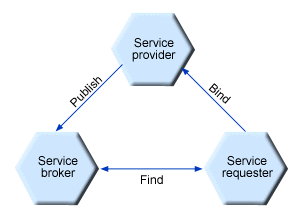
The Web services architecture includes three roles:
Web service providers can also unpublish components (remove them from the repository) when they are no longer needed.
Service broker
Web service brokers categorize Web services as they are published, and search for them as service requests are received. Web brokers are roughly analagous to Internet search engines, except that they locate components instead of Web pages. The Universal Description, Discovery, and Integration (UDDI) specification defines a way to publish and discover information about Web services.
Service requester
Web service requesters look up, or locate and invoke components as services. They act as the client for published Web services.
This diagram illustrates how client and server roles can interact to provide Web services.

Refer to the following topics for more information about Web services architecture:
Characteristics of the Web service architecture
The presented SOA employs a loose coupling between the participants, which provides greater flexibility in the following ways:
Properties of a service-oriented architecture
The service-oriented architecture offers the following properties:
On the client side, no additional software is required. A programming language with extensible markup language (XML) and Hyper Text Transport Protocol (HTTP) client support is enough to get you started. On the server side, a Web server and a SOAP server are required. It is possible to Web services-enable an existing application without writing a single line of code.
Neither the client nor the server knows or cares about anything besides the format and content of request and response messages (loosely coupled application integration). The definition of the message format travels with the message; no external metadata repositories or code generation tool are required.
This technology uses established lightweight Internet standards such as HTTP. It leverages the existing infrastructure. Some additional standards that are required to do so include SOAP, WSDL, and UDDI.
Client and server can be implemented in different environments. Existing code does not have to be changed in order to be Web service enabled.
XML and HTTP are the major technical foundation for Web services. A large part of the Web service technology has been built using open-source projects. Therefore, vendor independence and interoperability are realistic goals this time.
Dynamic e-business can become reality using Web services because, with UDDI and WSDL, the Web service description and discovery can be automated.
Simple Web services can be aggregated to more complex ones, either using workflow techniques or by calling lower-layer Web services from a Web service implementation. Web services can be chained together to perform higher-level business functions. This shortens development time and enables best-of-breed implementations.
There are a lot of commonalties, as well as a few fundamental differences to other distributed computing frameworks. For example, the transport protocol is text based and not binary.
Traditionally, application design has depended on tight interconnections at both ends. Web services require a simpler level of coordination that allows a more flexible re-configuration for an integration of the services in question.
The approach provides no graphical user interface; it operates at the code level. Service consumers need to know the interfaces to Web services but do not need to know the implementation details of services.
Already existing stand-alone applications can easily be integrated into the service-oriented architecture by implementing a Web service as an interface.
You should plan your use of Web services that are developed and implemented based on the Web Services for Java 2, Enterprise Edition (J2EE) specification.
To plan to use Web services based on Web Services for J2EE, consider the following decision points:
Design Web services to fit your e-business solution.
Consider what you want to accomplish by using Web services, how Web services fit into
your current topology, applications and programming model. Decide how the
Web services will process requests on the server and how the clients will
manage and use the Web service.
Design your Web services for reliability, availability, manageability and security. For example, you want your Web services to process a transaction in a reasonable time at all hours of the day and provide users with good security characteristics, such as authentication for buyers. Planning to use Web services to work with WebSphere Application Server - Express helps to meet these requirements.
To support Web services, extend WebSphere Application Server - Express to support Web services standards. For interoperable Web services running on platforms supplied by multiple vendors, standards are essential. WebSphere Application Server - Express uses Web services standards developed for the Java language under the Java Community Process (JCP). These standards include the Web Services for J2EE and JAX-RPC specifications.
Decide what development and implementation tools to use.
You can use a variety of manual development and implementation tasks.
Whether you have an existing Web service to implement or you want to develop
your own from a Java bean, you can choose different
tasks respective to your resources. You can also use the WebSphere Development Studio for iSeries to complete development and implementation tasks.
See Develop Web services for information about developing Web services based on the Java language through WebSphere Application Server.